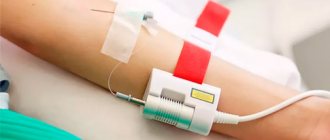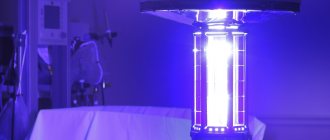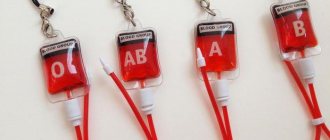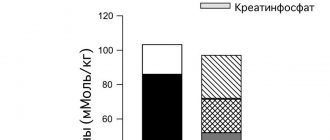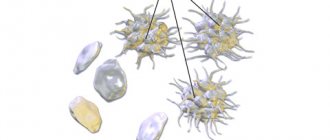UFOB, or ultraviolet blood irradiation, is a procedure in which human blood is exposed to ultraviolet optical radiation. Today this method of treatment has gained great popularity. This is due to its simplicity, safety for the human body, as well as good performance indicators. This method has been successfully used for more than 70 years. During this time, we managed to hone as much as possible how to use it in order to achieve the best results.
Ultraviolet blood irradiation (UFOI) is carried out using special equipment - a source of low-intensity ultraviolet radiation. As the name suggests, the method involves irradiating a small amount of the patient’s blood (1-3 ml per 1 kg of weight) with ultraviolet quanta. Under the influence of ultraviolet radiation, complex biochemical and biophysical processes are launched in the blood, which lead to an improvement in human health.
UFOK is a safe and effective procedure that has been used for many years in various areas of clinical practice. It stimulates a person’s own compensatory capabilities and can be used both independently and in complex therapy for many diseases.
As a result of UVOC, oxygen transport is improved, the risk of blood clots is reduced, the immune system is strengthened and metabolic processes are stimulated, tissue regeneration improves, and antispasmodic and vasodilating effects appear.
Indications for UVOC
Indications UFOK is indicated for acute and chronic inflammatory diseases of various organs:
- in gynecology for colpitis, endometritis, vaginitis, etc.
- in urological practice: for prostatitis, urethritis, cystitis;
- in proctology: for paraproctitis, perianal fissures.
The use of UVOC is allowed for such severe pathologies as sepsis.
The positive effect of this procedure has been proven for intoxication of various etiologies: drug poisoning, alcohol intoxication.
Any sluggish inflammatory process with frequent exacerbations can serve as a basis for prescribing UVOC. In case of chronic tonsillitis, sinusitis, adnexitis and other diseases, the prophylactic procedure can achieve a significant reduction in the frequency of disease relapses.
The stimulating effect of ultraviolet radiation on the blood on the activity of the endocrine glands provides sufficient grounds for prescribing this procedure for diabetes mellitus, menstrual irregularities in women, and decreased potency in men caused by hormonal factors.
Blood irradiation occupies an important place in terms of the prevention of cardiovascular diseases, since exposure to ultraviolet light on the blood leads to an improvement in the rheological properties of the blood - a decrease in viscosity and coagulability. This allows for the prevention of strokes and heart attacks.
How is treatment carried out?
Initially, it is worth noting that ultraviolet irradiation of blood is done under completely sterile conditions. To carry out the entire procedure, you will need a special apparatus, as well as a needle with a diameter of 0.8-1.2 mm. It is injected into a vein, after which a certain volume of blood flows through an ultraviolet ray of light, and so all the blood in the body is gradually purified.
Total procedure time: from 10 to 50 minutes, and the entire course of treatment ranges from 5 to 10 sessions. The result is visible after the first 2-3 procedures.
A little history
Humanity has been using light for medicinal purposes for a long time. With the development of medicine, this use has become systemic, for example, sunbathing.
The era of electricity took a huge step towards the development of new technologies and made it possible to use light waves in the treatment of various diseases.
At the very beginning of the twentieth century, a Danish scientist and doctor proved that light acts in different ways and that this depends on the wavelength, as well as the duration of exposure. With the advent of lasers, doctors were able to control the emitted light more precisely.
In the 1930s, the first devices appeared in the USSR, with the help of which doctors influenced the patient’s blood. This was irradiation of blood outside the body, and already in the early 1980s. It became possible to deliver light directly into the patient’s bloodstream, intravenously. This is how a fundamentally new direction began to develop – intravenous laser irradiation.
What does ILBI do?
ILBI in the clinics of JSC Family Doctor
Laser blood purification:
- helps improve immunity;
- has a vasodilating effect;
- improves blood microcirculation, has an anti-edematous effect;
- increases the oxygen transport function of the blood;
- helps reduce inflammation (antibacterial effect);
- normalizes metabolic processes (ensures normalization of protein, lipid, carbohydrate and intracellular energy balance);
- has an analgesic effect.
The healing effect of the procedure lasts from 4 to 6 months.
Prices for services:
| Therapy and additional services | Price |
| A set of basic tests during hospitalization | 5,500 rub. |
| Oxygen therapy | 1,500 rub. |
| ILBI | 2,200 rub. |
| Ozone therapy | 2,200 rub. |
| Plasmapheresis | 13,500 rub. |
| Xenon therapy | 12,500 rub. |
| Doctor consultations | Price |
| Initial consultation by phone | For free |
| Initial consultation for relatives by phone | For free |
| Consultation with a psychologist | 3,600 rub. |
| Consultation with a psychotherapist | 3,600 rub. |
| Consultation with a psychiatrist-narcologist | 3,600 rub. |
| Consultation with a psychiatrist-narcologist at home | 5,500 rub. |
* A full list of clinic services is presented on the “Prices” . Please note that this price list is not an offer and in order to avoid possible misunderstandings, please be sure to check the cost of services on the day of your call by calling +7 or 8 (the call is free!).
Ozone therapy
The bactericidal, viricidal and fungicidal effects of ozone are manifested by the external use of high concentrations of ozone gas and ozonated solutions. Moreover, ozone is more effective in a humid environment, since the decomposition of ozone in water produces a highly reactive hydroxyl radical. Ozone kills all types of bacteria, viruses, fungi and protozoa. Moreover, unlike many antiseptics, ozone does not have a destructive or irritating effect on tissue, since the cells of a multicellular organism have an antioxidant defense system.
Restoring the oxygen transport function of the blood. Ozone therapy provides increased oxygen delivery to insufficiently supplied tissues, which was confirmed based on analysis of the blood gas composition: the partial pressure of oxygen in the venous blood after a course of ozone therapy decreases from 40 to 20 mm Hg. Art. This means that more oxygen is released into tissues suffering from a lack of blood supply - an effect that cannot be achieved with medications. Ozone does not have a destructive effect on tissues and cells; it restores or increases normal cellular oxidation, which has been reduced by the disease state. Blood in the presence of ozone can absorb 2-10 times more oxygen than under normal conditions, since in this case the oxygen dissolves in the plasma. Experiments have proven the tropism of ozone for fabrics and its fixation by fabrics. In the process of ozone therapy, oxygen saturation occurs in both blood serum and red blood cells. In this case, it is possible to maintain metabolism through the extracellular fluid, despite impaired vascular tone. When carrying out major autohemotherapy with ozone, all treated patients showed a statistically significant increase in the partial pressure of oxygen in arterial blood, a decrease in the partial pressure of carbon dioxide and an increase in hemoglobin content. After cessation of treatment, the elevated oxyhemoglobin reduction time point decreases very slowly, over several weeks and even months (up to 6 months). Thus, increased oxygen content in the blood can have a therapeutic effect even when ozone treatment has already been stopped.
Optimization of antioxidant systems. Since during ozone therapy reactive oxygen species enter the body, it is very important to consider the effect of ozone on the process of lipid peroxidation (LPO). Numerous studies have shown that therapeutic doses of ozone stimulate the antioxidant system and reduce the intensity of lipid peroxidation.
Metabolism optimization. Ozone therapy activates lipid metabolism, in particular the oxidation of fatty acids, by both direct interaction of ozone with lipids in the bloodstream and by stimulating the body's antioxidant defense system. There is evidence that when administered parenterally, ozone can stimulate the work of hepatocytes, including those aimed at processing lipid fractions. As a result, there is a decrease in the level of lipids in the blood plasma (especially cholesterol and atherogenic fractions of lipoproteins), as well as carbohydrates and a number of under-oxidized products. The discovered mechanism of ozone action is very important, as it can influence the development of atherosclerotic vascular damage. In addition, a decrease in cholesterol content in membranes leads to normalization of membrane fluidity, hemorheology, and the functioning of membrane-bound enzymes and is accompanied by a noticeable clinical improvement. Under the influence of ozone, the concentration of glucose in the blood decreases, and the content of lactate in the blood also decreases.
| Ozone therapy helps reduce blood clotting, restore microcirculation and peripheral circulation. Ozone acts at all stages of the complex enzymatic chain reaction, which is the process of blood coagulation, unidirectionally, moderately shifting the coagulation homeostasis system towards reducing the coagulation ability of the blood, thereby preventing intravascular thrombus formation, especially in areas with slow blood flow. By reducing blood viscosity and coagulability, ozonized isotonic sodium chloride solution improves microcirculation. Many studies have shown that one of the effects of ozone therapy is the improvement of peripheral blood circulation and microcirculation. |
Analgesic effect. For many diseases, one of the leading symptoms of which is pain, the analgesic effect of ozone therapy has been obtained. It may be related to several things:
- the anti-inflammatory effect of ozone is due to its modulating effect on prostaglandins, which regulate cellular reactions (ozone prevents the modulation of the arachidonic acid cascade),
- due to increased tissue oxygenation, metabolism and elimination of products that cause activation of pain receptors are enhanced,
- as a result of the release of oxygen, the cation-anion ratio in the altered cell membrane is re-established, and ozone acts electrophysiologically as a true pain antagonist,
- the reduction in pain may be due to inhibition of catabolic cartilage enzymes.
Blood plasmapheresis
Blood plasmapheresis is a method of modern medicine, which is used for the treatment and prevention of various diseases, stimulation of the body's defenses, healing and rejuvenation. The membrane plasmapheresis method is based on the separation of blood into fractions using a plasma filter consisting of many porous track membranes. Pores (holes) in the membrane allow blood plasma to pass through and retain formed elements. Thus, during the passage of blood through the plasma filter, plasma containing antigens, antibodies, circulating immune complexes, inflammatory mediators, excess fibrinogen, cryoglobulins, bacteria and their toxins, tissue and cell breakdown products is removed, and the formed elements are returned to the vein with adequate replacement various infusion media (crystalloids, colloids, donor plasma, albumin).
| The mechanism of the therapeutic effect of plasmapheresis is associated not only with the mechanical removal of toxic substances, but also with the general reaction of the body to exfusion. When blood loss occurs, mechanisms for activating the body's defenses are triggered: the sympathoadrenal system is activated, metabolic processes between water sectors change, tissue protein, iron reserves and other plastic materials are mobilized, hematopoiesis is stimulated with the acceleration of cell maturation in the bone marrow. Blood dilution with a preservative, hemodilution with infusion media, and deplasmization of erythrocytes and other cells are also important. |
Blood plasmapheresis provides:
- increasing the functional activity of hematopoietic, phagocytic and immunocompetent cells,
- immunocorrection and improvement of blood microcirculation,
- anti-inflammatory effect,
- removal of decay products of tissues and cells (during hemolysis, myoglobinemia), microbes, toxic substances, including those associated with proteins.
It is very important that one vein is used to operate the system, and the system is not disconnected during operation. This protects the patient from infection and increases the safety of the procedure as a whole. Membrane plasmapheresis is characterized by a number of advantages: absence of injury to blood cellular elements, good tolerance of the procedure even by elderly and seriously ill people, guarantee against infection, use of one vein, sterility and disposability of all materials used.
Contraindications
There are a number of contraindications for which it is strictly forbidden to carry out ultraviolet irradiation of blood.
Initially, this is an individual intolerance to sunlight , or any skin diseases associated with ultraviolet rays. You cannot do ultraviolet irradiation of blood if you have cancer, hemophilia, tuberculosis, AIDS, or syphilis. There are other options, which should be discussed with your doctor or physiotherapist.
In the “SM-Clinic” of St. Petersburg, you can do ultraviolet irradiation of blood, after first consulting with a specialist, as well as passing a series of tests. Only an accurate diagnosis makes it possible to prescribe a type of treatment that will be aimed not at harm, but at benefit to the patient. The entire procedure is carried out exclusively in sterile conditions, under the supervision of a doctor who monitors changes and can adjust the treatment.
| Name of service (price list incomplete) | Price, rub.) | In installments* |
| AUFOK without drugs | 1 100 | — |
| AUFOK with ILBI | 1 300 | — |
| AUFOK with Immunomax | 1 300 | — |
* You can read more about the conditions here - Treatment on credit or in installments.
What are the effects based on?
The latest technologies have made it possible to develop to the incredible, to improve what humanity has known about since ancient times. So this technique developed the idea of light therapy to the maximum.
Its beneficial effects on the body can be called complex. It is provided at 3 levels:
- The impact of light energy quanta on blood elements;
- Improving blood properties;
- Systemic response at the level of tissues and organs.
Hysteroresectoscopy
Literature
- Vetchinnikova O. N. Extracorporeal ultraviolet irradiation of blood // Doctor, 1995. – No. 3 – P. 3–6.
- Isakov V. A., Evgrafov V. D., Vodeyko L. P. et al. Extracorporeal photohemotherapy in the treatment of viral infections - St. Petersburg: Hippocrates, 1996. - 48 p.
- Karandashov V.I., Chernyakov V.L., Vetchinnikova O.N. et al. Extracorporeal ultraviolet irradiation of blood in clinical medicine - St. Petersburg: Hippocrates, 1992. - 48 p.
- Krylenko V. A., Odintsov E. S., Darinskaya V. S., et al. To the mechanism of therapeutic action of blood irradiated with ultraviolet radiation. // Anesthesiology and resuscitation – 1987 – No. 1. – pp. 29–32.
- Lirtsman I.V., Filyukova O.B. Assessment of the influence of extracorporeal ultraviolet irradiation of autologous blood of patients in terminal conditions on some indicators of cellular immunity //Anesthesiology and Reanimatology - 1991. - No. 2. – pp. 37–38.
- Treshchinsky A.I., Vasiliev G.A., Sheiman B.S. and others. Ultraviolet irradiation of autologous blood in the clinic. // Medical practice – 1984 – No. 3. – pp. 11–16.
When is it necessary to do UVOC?
Intravenous ultraviolet irradiation is prescribed for intolerance to drugs for cleansing, removing drugs, ethanol metabolites. After eliminating the consequences of intoxication, the patient's condition quickly improves. Headaches, tremors, sleep problems disappear, and the craving for alcohol and drugs decreases.
Indications for cleaning:
- withdrawal syndrome in chronic alcoholism, binge drinking;
- severe hangover, withdrawal symptoms;
- delirium;
- acute mental disorders;
- overdose of narcotic substances, poisoning with surrogate alcohol-containing products.
UFO is prescribed in case of a breakdown after drug coding, which reduces the risk of developing severe complications. UFOK eliminates the clinical manifestations of post-withdrawal syndrome after the first session. When the cleansing course is completed, psychologists work with the patient. If a person is ready, clinic specialists select effective rehabilitation methods.
What are the benefits of intravenous laser blood irradiation?
Local therapist
Ablyazov
Irshat Ravilevich
20 years of experience
Local therapist of the highest category. Member of the Russian Scientific Medical Society of Therapists.
Make an appointment
According to some patients, the very term “irradiation” causes some mistrust (probably due to the fact that it is associated in the mind with a completely different exposure - radioactivity, radiation therapy, nuclear power plant accidents, etc.), and then there is intravenous exposure.
The first question that a person has regarding intravenous laser irradiation of blood seems to be: why intravenous irradiation and not irradiation through the skin?
The explanation for this is quite simple: any laser effect on organs (including intracavitary) is, first of all, an effect on the blood. The fact is that light with a wavelength of 630-635 nm penetrates the body no more than 6-8 mm, regardless of how the irradiation is carried out. Therefore, it is difficult to assume that external (percutaneous) laser irradiation, for example, of a knee joint with arthrosis, eliminates pain as a result of exposure to light on the joint cavity, cartilage, ligaments, etc. Laser light simply does not reach these structures. However, during such exposure, the skin and subcutaneous structures in which blood flows are irradiated.
It is the irradiation of the blood that provides all the effects inherent in laser exposure. The biological effect of laser radiation with a wavelength of 632 nm (red) and a power of 1-1.5 mW is due to the effect of increasing the degree of deformability of red blood cells - erythrocytes. Red blood cells are blood cells that carry oxygen from the lungs to the body tissues, and carbon dioxide (CO2) in the opposite direction. The oxygen transport function of erythrocytes is vital for humans, since without oxygen in the cells of the body it is impossible to form energy and, therefore, it is impossible to carry out all those physical and chemical processes that constitute the essence of life, both an individual living cell and the entire organism as a whole.
Deformability is the ability of red blood cells to change their shape at a constant volume and surface area. The degree of deformability plays a huge role in the functioning of the microvasculature. As is known, the diameter of the smallest human blood vessels - capillaries, in which (and only in which) gas exchange occurs between the erythrocyte and the cells of surrounding tissues - ranges from 1 to 20 micrometers (μm), and the diameter of the erythrocyte is about 7.5 μm. In the case when the diameter of the capillary is smaller than the diameter of the red blood cell, which also has high rigidity (i.e., is not able to deform and squeeze into capillaries with a diameter of 2-4 microns), gas exchange in the tissues will be ineffective, oxygen will not enter the cells, energy the capabilities of such cells will decrease, which will cause disruption of cell functions and, ultimately, lead to health problems.
Currently, a decrease in the degree of erythrocyte deformability (DE) has been established in such human conditions and diseases as:
- dyspepsia in children 1 year of life,
- arterial hypertension,
- cardiac ischemia,
- acute myocardial infarction,
- diabetes,
- metabolic syndrome and its manifestations,
- atherogenic dyslipidemia (including cholesterolemia),
- acute pneumonia,
- accumulation of lipid peroxidation products and depletion of antioxidant protection,
and also when:
- displacement of the pH of the medium in any direction from the value of 7.4,
- changes in environmental temperature (the highest degree of deformability of human erythrocytes is observed at a temperature of 36.6°C).
The inclusion of ILBI in treatment regimens and drug support for patients with the listed diseases can significantly (and often dramatically) improve the well-being and condition of the absolute majority of patients. Among the already established effects of ILBI, the following should be noted:
Reducing the frequency of transition of angina to a more severe functional class by 2.8 times.
Reducing the mortality rate and the incidence of acute myocardial infarction in patients with coronary artery disease by 2 times.
The lengthening of remission periods for angina pectoris was on average 2.5 times compared to the group of patients who received only traditional pharmacotherapy.
Reduction by more than 2 times of the area of lipid deposits on the internal lining of the aorta (the effect was shown in the experiment).
A pronounced and long-lasting improvement in the vast majority of patients with angina pectoris, which manifests itself mainly in the antianginal and antiarrhythmic effect, and an increase in exercise tolerance.
Hypotensive (lowering blood pressure) effect in arterial hypertension.
Antiviral, antibacterial effects, increasing tissue resistance to the damaging effects of microorganisms.
Anti-inflammatory effect – rapid and effective removal of all signs of inflammation (tissue swelling, pain, etc.), significantly exceeding the speed of all known pharmacological drugs. A very good effect is observed in patients with arthritis and arthrosis.
Healing of ulcerative and wound tissue defects without rough scars.
Softening and resorption of scars and adhesions.
Rapid restoration of bone, cartilage, liver, lung and nerve tissue.
Increasing sensitivity to medications, allowing you to reduce their dosage (antibiotics, hormones, nitrates, psychotropic drugs, etc.) and shorten the time for the onset of effect.
Decreased secretion of the glands of the gastrointestinal tract and pancreas.
Bronchodilator effect, improvement of respiratory function.
Tonic effect on the ovaries, thyroid gland, adrenal glands, mammary glands (stimulation of lactation).
Antiallergic effect. Improving the condition of patients with multiple sclerosis. Elimination of pain in chronic cystitis in women
The above effects of ILBI are only part of the therapeutic potential of ILBI, which is currently being discovered in those areas of medicine in which this technique is used. As is known, the human body includes approximately 300 types of cells that have the same genetic code, but perform very different functions: muscle cells, the epithelium of various organs, cells that produce hormones (insulin, thyroxine, adrenaline), etc. All our cells will work normally only when conditions are created for them to produce energy. The main ones of these conditions are the delivery of oxygen and glucose. And if glucose dissolves in plasma and easily penetrates everywhere, then oxygen delivery is provided by red blood cells (one red blood cell simultaneously “transports” about 1 billion oxygen molecules) and is very dependent on their degree of deformability. The ILBI method is especially valuable in the treatment of diseases of the cardiovascular system. In 1989, a group of scientists and doctors was awarded the USSR State Prize for the development of the ILBI method for the treatment of patients with angina pectoris and acute myocardial infarction. Currently, the latest technology for intravenous blood irradiation, ILBI-405, is being actively developed. Studies have shown that the blue spectrum of LILI, closer to the ultraviolet region (UVR), is more effective for this technique. The wavelength of 405 nm combines the advantages of LILI of the red and ultraviolet spectra and is optimal for normalizing the immune system, since it is in this region of the spectrum that there is a maximum absorption of immunocompetent cells.
For a preventive course, 3-4 procedures lasting 2-3 minutes are sufficient (max. up to 5 minutes).
In this case, such effects appear as: an increase in the phagocytic activity of macrophages, an increase in the number of lymphocytes and a change in their functional activity, an increase in the ability of T-lymphocytes to form rosettes, activation of DNA synthetic activity of lymphocytes, stabilization of the ratio of the T-helper/T-suppressor subpopulation, an increase in blood serum content of IgA, IgM, Ig, etc. Like most treatment methods, there are contraindications for ILBI. In particular, ILBI is not recommended for such conditions as: - Continued bleeding or its threat Hypoglycemia and a tendency to it Extremely severe septic conditions Feverish states of unknown etiology Cardiogenic shock Hemorrhagic stroke Hypertensive crisis Severe arterial hypotension Severe renal failure End-stage hemoblastosis All forms of porphyria and pellagra Photodermatoses and increased sensitivity to sunlight. Acquired hemolytic anemia Epilepsy.
VLOK HAS NO CARCINOGENIC OR MUTAGENIC EFFECTS!!!
The ILBI method is an almost ideal means of creating the most favorable conditions for the functioning of the whole organism. Even in so-called practically healthy individuals of any age. Deep scientific study and predictability of results contribute to the use of ILBI both independently and in combination with other treatment methods.
One course of treatment includes 7-15 sessions of ILBI.
Frequency – 1 course with an interval of 6 months.
